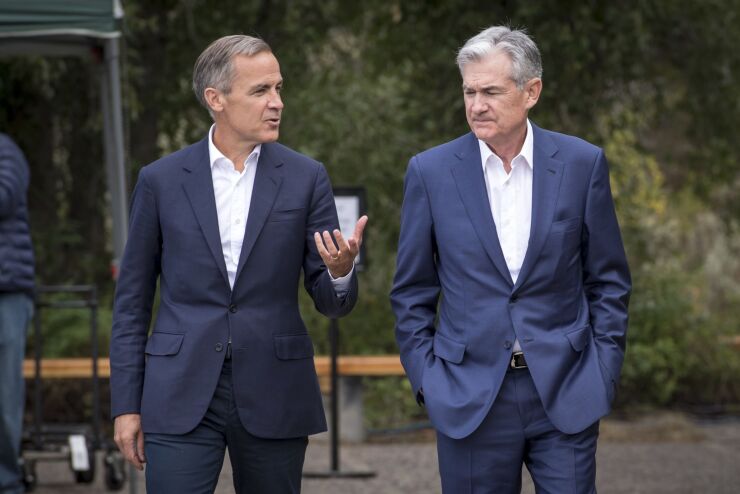While some Federal Reserve Bank presidents offered hawkish remarks at the Jackson Hole symposium, the markets still expect a 25 basis point cut at the September Federal Open Market Committee meeting, and analysts agree.
Fed officials pointed a finger at trade issues for the global slowdown, and Fed Chair Jerome Powell said in his speech that monetary policy “cannot provide a settled rulebook" for international trade.
“While the speech did not explicitly guide to market pricing, it echoed dovish elements of the July FOMC minutes in reiterating a risk management approach, acknowledging deterioration in trade and global growth, and again pointing to financial conditions as a driver of the outlook,” Andy Schneider, U.S. economist, and Timothy High, U.S. rates strategist, G10 Rates Americas, at BNP Paribas Securities Corp., wrote in a note. It “clearly set the stage for the Committee to continue easing policy going forward.”

BNP sees cuts in September, December and then once in the last half of 2020. “We think a September cut is likely regardless of developments; given the current risk picture and logic of risk management, we think the Committee will cut 25bp along similar lines as in July.”
Morgan Stanley researchers agree that a quarter-point rate cut is coming in September. “The economy is softer and by our measure recession risks have increased, but it's certainly not ‘falling off a cliff,' " the researchers write, “and given those factors, “the Fed will deliver further measured cuts as insurance.”
In a separate note, Morgan Stanley researchers said, “We view risks of further [trade war] escalation as meaningful. If the U.S. raises tariff on all imports from China to 25% and China makes a matching response with these measures staying in place for 4-6 months, we believe that the global economy will be in recession in 6-9 months.”
The U.S. can better withstand a trade war, than other major global economies, said John Swarr, CFA, investment specialist at Penn Mutual Asset Management. “The current trade war is displacing manufacturing jobs from China as supply chains shift more nimbly to other countries.”
But the U.S. economy, buoyed by the consumer sector boosted by a strong labor market, remains healthy. The impact will be felt as business investment will be put off until issues are resolved.
“After the political posturing and feather ruffling has settled, I expect both sides will come to realize that a deal is in the best interests of both parties economically,” Swarr said. “If a deal is made that lifts tariffs and opens up China’s market, then interest rates should go higher as global growth prospects improve. The U.S. economy should get a boost from business investment as the uncertainty the trade war brought to the business environment is lifted.”
Durable goods
New orders for durable goods rose 2.1% in July after a 1.8% gain in June. Excluding transportation, orders fell 0.4% in the month after a 0.8% increase the month before.
Economists polled by IFR Markets expected a 1.1% gain in the headline number and a flat reading excluding transportation.
Shipments dropped 1.1% in the month after a 1.0% increase in June, and most shipment categories were soft.
Orders of nondefense capital goods excluding aircraft rose 0.4%, suggesting the sector could stabilize soon, albeit at a sluggish growth pace.
Manufacturing
The Federal Reserve Bank of Dallas’ Texas Manufacturing Outlook Survey suggested a pickup in activity, as the general business activity posted a 2.7 reading in August, its first positive number in four months, and the production index grew to 17.9 from 9.3 a month before.
“This was a very positive report for Texas manufacturing, with most indexes signaling a notable acceleration in growth from last month,” said Emily Kerr, Dallas Fed senior business economist. “Outlooks improved, with the index turning positive after negative readings for the past three months. But, uncertainty regarding those outlooks increased quite a bit, and comments from Texas business executives continue to cite concerns regarding tariffs and trade tensions, particularly with China.”
Economic activity
The Chicago Fed National Activity Index (CFNAI) dropped to negative 0.36 in July from positive 0.03 in June. While the four categories of indicators all made negative contributions to the index in July, production-related indicators were the biggest drag at negative 25, the Fed said. The index’s three-month moving average, CFNAI-MA3, moved up to negative 0.14 in July from negative 0.30 in June.





